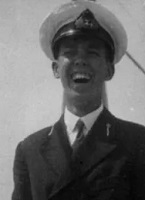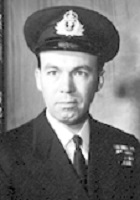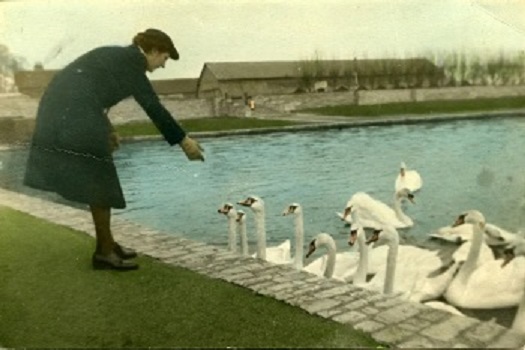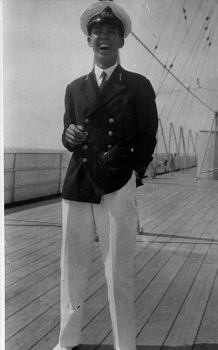|
In memory of those who have Crossed the Bar
Then Lt John W. McDowall married Grace Kelso Lovatt, LCdr (S), WRCNS, ret'd in 1947
Ships served in: HSM EXCELLENT - Appointed to EXCELLENT 07 Sep 1937 as a Naval Cadet, RCN (seniority 20 Aug 1937) (Navy List Sep 1937) HMS EREBUS - Appointed to EREBUS for Training, Special Entry No. 43) - 1937 (The Nauticapedia) HMS VINDICTIVE - Appointed to VINDICTIVE 11 Jan 1938 as a Naval Cadet, RCN (Navy List Apr 1938) HMS REVENGE - Appointed to REVENGE 01 Sep 1938 as a Midshipman, RCN (seniority 01 Sep 1938) (Navy List Oct 1938, Vol III) HMS RAMILLIES - Appointed to RAMILLIES 02 Feb 1939 as a Midshipman, RCN (Navy List Apr 1939) HMS REVENGE - Appointed to REVENGE as a Midshipman, RCN (Navy List Jun 1940) * Appointed A/SLt (seniority 01 May 1940) (Navy List Aug 1940) HMCS STADACONA - Appointed to STADACONA (RCN BARRACK HALIFAX) 20 Sep 1940 as an A/SLt, RCN, For Disposal or Under Training (Navy List Oct 1940) * Appointed SLt (seniority 01 May 1940) (Navy List Nov 1940) HMCS SKEENA - Appointed to SKEENA as a SLt, RCN (Navy List Feb 1941) * Appointed Lt (seniority 15 Sep 1941) (Navy List Dec 1941) HMCS SAGUENAY - Appointed to SAGUENAY 26 May 1942 as a Lt, RCN (Navy List Sep 1942). Served as CO 15 Jan 1943 - 11 Mar 1943 as a Lt, RCN (Mcpherson / Burgess - Ships of Canada's Naval Forces 1910-1981) * Listed as Training with the Royal Navy eff 12 Apr 1943 (Navy List Aug / Oct 1943) HMCS STADACONA - Appointed to STADACONA30 Oct 1944 as a Lt, RCN, Add'l, For Disposal or Under Training * Listed as Lt (G) (Navy List Jan 1945) * Listed as Training with the Royal Navy (Navy List Mar 1945) NAVAL SERVICE HEADQUARTERS OTTAWA - Appointed to NSHQ OTTAWA, Staff of Deputy Director Naval Ordnance, 25 Feb 1946 as a Lt (G), RCN (Navy List Apr 1946) HMCS ONTARIO - Appointed to ONTARIO - 01 Jul 1948 as a Lt (G), RCN (Navy List Jul 1948) * Appointed LCdr (seniority 15 Sep 1949) (Navy List Sep 1949) HMCS NADEN - Appointed to NADEN, Staff of Flag Officer Pacific Coast, Command Gunnery Officer 01 Sep1949 as a LCdr (G), RCN. Also listed as Officer-in-Charge Gunnery Training Centre, RCN BARRACKS ESQUIMALT (Navy List Jan 1950) HMCS BEACON HILL - Appointed to BEACON HILL 22 Sep 1951 as a LCdr (G), RCN, C.O. (Navy List Jan 1952) NAVAL HEADQUARTERS OTTAWA - Appointed to NHQ OTTAWA as Deputy Director of Naval Training 05 Oct 1953 as a LCdr, RCN (Navy List Oct 1953) * Appointed Cdr (seniority 01 Jan 1955) (Navy List Jan 1955) HMCS NIOBE - Appointed to NIOBE for RN Staff Course 17 Mar 1955 as a Cdr (G), RCN (Navy List Jul 1955) HMCS STADACONA - Appointed to STADACONA for FOPC, as Staff for FOPC, Assistant Chief of Staff (Plans and Operations) and on staff of Commander Canadian Atlantic as Assistant Chief of Staff (Plans and Operations) 17 Oct 1955 as a Cdr (G), RCN (Navy List Jul 1956) HMCS STADACONA - Appointed to STADACONA, Add'l for RESTIGOUCHE 17 Oct 1955 as a Cdr (G), RCN (Navy List Jan 1958) HMCS RESTIGOUCHE - Appointed to RESTIGOUCHE 07 Jun 1958 as a Cdr (G), RCN, C.O. (Navy List Jul 1958). 1st Commanding Officer HMCS NADEN - Appointed to NADEN 26 Aug 1960 as a Cdr (G), RCN (Navy List Jan 1961). Appointed as Training Commander Fleet School (Navy List Oct 1961). Appointed at Training Officer (Navy List Apr 1962). HMCS NADEN - Appointed to NADEN 04 Jun 1962 as a Cdr, RCN, XO (Navy List Oct 1962) CF HQ OTTAWA - Appointed to CF HQ OTTAWA as Staff of Deputy Chief Operations Readiness 24 Aug 1964 as as Cdr, RCN (Navy List Oct 1964) CF HQ OTTAWA - Appointed to CH HQ OTTAWA, Training and Transient 07 Dec 1964 as a Cdr, RCN (Navy List Apr 1965) FIXED TRI SERVICE - Attached to FIXED TRI SERVICE as Attaché to Soviet Union and Finland 10 Aug 1965 as a A/Capt, RCN (Navy List Oct 1965)
Two small pieces of World War II’s sweeping narrative
Seventy years after Allied victory, Canadian historian Duncan McDowall tells a personal tale about a shard of glass and a telescope — mementoes from his mother and father’s very different experiences of war.
DM By Duncan McDowall - Special to the Star Published in the Toronto Star 02 Aug 2015
The memory of war persists. As societies, we construct rituals and sites of commemoration that perpetuate the agony and ecstasy of military conflict. Every November, we wear poppies. We imprint our money with John McCrae’s poem of sacrifice in the trenches. We commission war artists. We build cenotaphs. As individuals, we fashion more intimate sites of remembrance — a faded picture on the mantle, a bundle of dog-eared letters tucked in a drawer. This is the story of two such mementoes.
In the early afternoon of Sunday, July 23, 1944, Sub-Lt. Grace Lovatt left her office in central London’s Haymarket in search of a tearoom and a respite from wartime bureaucracy.
She was a member of the Women’s Royal Canadian Naval Service — a “Wren.” The Wrens were formed in 1942 to augment Canada’s wartime naval effort by admitting women to behind-the-scenes logistics roles, slotting them into “trades” as various as sick-berth attendant and cipher clerk.
By the end of the Second World War, 7,000 Canadian women would serve their nation as shore-bound sailors. Just over 500 of them, including Lovatt, made it across the Atlantic, where they served as part of “Operation Neptune,” the gigantic effort to gird Allied forces for the surge across the Channel in June 1944.
A year earlier, Lovatt had been a student at the University of Manitoba. Her year of university made her officer material. Trained at HMCS Conestoga in Galt, Ont., Lovatt was ready for duty by the fall of 1943. She would be a paymaster, a vital role that saw her assigned to the first overseas draft of Wrens. Her hometown Winnipeg Tribune dubbed her a “prairie sailor.”
Lovatt loved England. The work was indeed onerous: hundreds of women packed into King’s House on Haymarket, pushing paper day in and day out. But the thrill of a city in daily peril exhilarated her.
Grace’s first spring in London saw a return of intensive German bombing — “Operation Steinbock” or, as the Brits dubbed it, the “Baby Blitz.” Life in Haymarket was punctuated by hours spent huddling in shelters as Heinkel bombers pummelled the city. Novelist Graham Greene captured the verve of it all: “The bomb-bursts moving nearer and then moving away, hold one like a love-charm.”
Amid the frenzy, Grace Lovatt became an anglophile, embracing the rhythms of English life — tearooms, cinemas, feeding the swans in Hyde Park, weekend trips into sunny Sussex. And, with the first disposable income of her life, she began to indulge a passion for antiques.
Raised in Ottawa’s quiet, tree-lined neighbourhood of Sandy Hill, John McDowall had grown up in relative comfort. Many mornings he encountered a neighbour, Prime Minister Mackenzie King, out walking his Irish terrier. As his father had instructed him, young McDowall doffed his cap and issued a polite “good morning, sir” to the austere gentleman. King invariably patted him on the head and called him “sonny.”
In 1937, McDowall reached a fork in the road. Acceptance into the medical school at Queen’s University offered a promising, if conventional, path. But a restlessness brought on by the predictable orthodoxy of life in Ottawa pushed him toward the recruiting office of the fledgling Canadian navy. His high school grades got him on board as an officer candidate.
Canada’s peacetime navy was a paltry affair, pinched by Depression belt-tightening and reined in by King’s abiding fear of being pulled into another British military adventure. The navy was so small that it was obliged to dispatch its would-be officers to the Royal Navy for grooming. So it was to HMS Excellent, a “stone frigate” adjacent to the storied Portsmouth naval base, that McDowall was sent to master naval gunnery. There, he joined the ranks of the lowest of the low in the Royal Navy — as a midshipman, or “snotty” in naval parlance. His British shipmates dubbed him “Jake,” a nickname that would stick for life.
A week after the D-Day landings of June 6, 1944, a strange, warbling sound was heard above the city. It was the pulse jet propelling an unmanned, gyro-guided flying bomb, launched with German precision from bases along the French and Dutch coasts — the V-1 “buzz-bomb,” or the “doodlebug” as Londoners dubbed it with their usual insouciance.
When the warbling stopped, Londoners had only seconds before the bomb plummeted to earth. A 400- to 500-metre-wide ring of destruction ensued. The accompanying concussion ripped tiles off roofs for blocks around. By late June, doodlebugs had exacted a heavy toll: direct hits on Victoria Station and Wellington Barracks sharpened the knife of terror across London’s central boroughs.
On that Sunday, July 23, Lovatt left her office, walked up Haymarket, along Piccadilly and past Green Park. She paused in front of 81 Knightsbridge and looked into the window of the Venetian Glass Shop. For decades, the shop had offered an array of coloured Italian glass, crafted for centuries on the island of Murano in the Venice lagoon. Her eye fell longingly on a beautiful purple and gold dessert service. She decided she would ponder the purchase over lunch.
Minutes later, with Lovatt now settled in a nearby tearoom, the dreaded sound of a doodlebug broke her deliberation. For the next hour, she hunkered down in a nearby shelter. With the all-clear, Grace, now overdue at work, retraced her route through Knightsbridge. Horror awaited her. The Venetian Glass Shop had been blown to smithereens. (Exact casualty figures were unclear because of wartime censorship.)
But Grace spied a shard of the dessert service lying in the debris. She scooped it up, a memento of war’s painful unpredictability. Back at her office, she affixed a label to the shard of glass: “23rd July 1944 — 1512 [3:12 p.m.] — Doodlebug — Venetian Glass Shop — Knightsbridge.” She clung to this little keepsake for the rest of her life.
There was a certain prestige to being a midshipman. They sported white flashes on the epaulettes of their dark uniforms and equipped themselves with telescopes, which they adorned with intricately braided rope designs, as if to demonstrate their connection with the bygone age of sail. McDowall had his telescope engraved with his name. As an optical device, it offered paltry magnification; its power lay in the status it bestowed — like an army swagger stick, it projected the ambition of its bearer. War found Midshipman McDowall on the First World War-vintage battleship HMS Ramillies patrolling the Iceland gap. Britain had declared war on Sept. 3, 1939.
Back in Ottawa, Mackenzie King was making the conspicuous gesture of recalling Parliament before declaring Canada’s war, so as not to be seen as automatically acquiescing to London. Aware of this hiatus, the 19-year-old Canadian aboard Ramillies concluded that he was a non-belligerent on a belligerent warship. He thus sought a hearing before his captain, the grandly named Harold Tom Baillie-Gorham. The meeting was apparently short and the captain unsympathetic. McDowall thus went to war a week in advance of his compatriots.
In 1940, recently promoted Lt. McDowall left the teak decks of the Royal Navy’s capital ships and clambered aboard the steel decks of the now rapidly expanding Canadian navy. He was bound for convoy duty in the North Atlantic.
In August 1940, McDowall was ordered back to Canada to join the destroyer Skeena. To do so, he took passage across the Atlantic on the Holland America liner Volendam, now a troop ship. The vessel was carrying 321 British children being evacuated from their Blitz-battered homeland to safety in Canada. The Volendam joined convoy OB 205. A week on the one-time luxury liner offered a seeming respite from life on a topsy-turvy destroyer.
But one evening, as the ship moved out onto the Atlantic off the coast of Donegal, Ireland, just as McDowall left the dance floor and headed to the bar for a drink, two torpedoes from the German submarine U-60 slammed into the ship’s side. Volendam’s captain hastily pressed the young Canadian into service: he took command of a lifeboat of 35 British children and 12 Dutch seamen.
After they’d spent three hours rowing, a Norwegian banana boat, the Olaf Fostenes, appeared. In a delicate operation, the children were hoisted onto the ship in the baskets usually employed to load bananas. No lives were lost. When they landed in Glasgow, McDowall told the Globe and Mail “an old man gave me a sprig of heather and said to keep it and I wouldn’t get torpedoed again.”
Sub-Lt. Lovatt was my mother. Even as a child, I could sense that wartime London had been the defining moment of her life. She talked of things English with a passion. Throughout her remaining 45 years, she harboured a “finest hour” vision of Britain and resolutely screened out any elements of “cool,” multi-ethnic Britannia that sullied that idyll. In the ’50s, she returned to London as a civilian and renewed her anglophile subscription. Beside her house on Blackheath Common lay the wreckage of a bombed-out home. When it rained, an acrid stench rose from the debris, a reminder of harrowing wartime days.
Antiques became the badge of her affection for Britain. Along with the jagged bit of Murano glass, she carried other, more intact, artifacts of English heritage back to Canada tucked in her kit bag — a silver comb and brush set, Minton china and a mahogany-cased table clock.
The Scottish prophecy proved accurate: there were no more torpedoes in my father’s war. But danger found him in other ways. On a pitch-black night in November 1942, his ship, HMCS Saguenay, went about her guard duty off Cape Race, N.L., as part of Convoy WB 13. Convoys demanded navigational precision. Their slow-moving ships were required to zig and zag to confuse the submarines stalking them. There was much that could go wrong. A mix of languages made clear communication difficult. Some ships were faster than others. Running lights were prohibited. Predictably, convoys often became their own worst enemies.
The Panamanian-registered Azra wandered off course in the inky night and sliced into the Saguenay’s stern. A huge explosion followed as the Canadian destroyer’s depth charges detonated. The Azra and the Saguenay’s stern disappeared beneath the waves. Miraculously, the forward section of the destroyer stayed afloat. McDowall joined a desperate effort to keep the vessel from sinking. Two days later, the Saguenay limped into St. John’s, N.L., where a temporary coffer wall was welded to her battered stern.
She was subsequently towed to Saint John, N.B., for more substantial repair. Although the ship was never destined to go to sea again, McDowall was given command of the stricken vessel — his first full command.
The stern of the destroyer had contained the officers’ wardroom and cabins. Thus, in an instant, my father lost all his wartime possessions. His beloved telescope was gone.
In Saint John, he busied himself restoring his kit — new duffle coat, uniforms, shoes and all the paraphernalia of war at sea. One evening, there was a knock on his hotel room door. Was he “J.W. McDowall”? a man in a boiler suit asked. “Yes.” “Then this is yours,” the man said, thrusting a battered telescope into the lieutenant’s hands.
The shipyard worker had found it lodged in the Saguenay’s jagged stern. The inscription had given him the only clue he needed.
Dented by the explosion and discoloured by seawater, the telescope had lost its glass. But repaired by a local jeweller, it became the only surviving relic of McDowall’s hitherto short, but eventful, life at sea.
It travelled with him through the rest of the war, into further service on the Atlantic — in particular on the deadly Murmansk Run — and into the Pacific after VE-Day. And, finally, McDowall and the telescope sailed home on the Queen Mary in early 1946.
Grace Lovatt made another important wartime acquisition. On her 1946 repatriation voyage to Canada — via New York on the redoubtable RMS Queen Mary — she met a tall, dark-haired Canadian naval lieutenant, whom she would marry in 1947. Lt. John William McDowall of Ottawa had also filled his kit bag with memories and mementoes of the war just passed.
I will never know precisely how the courtship of Grace Lovatt and Jake McDowall unfolded on that crowded, war-weary liner as she made her way to New York. Did they talk of telescopes and Murano glass? I do know that their mementoes of war and the habits and attitudes they adopted in those years permeated their marriage and my childhood.
In 1949, according to naval custom, I was baptized in a ship’s bell, from the cruiser HMCS Ontario. In childhood, I played at being Horatio Nelson at Trafalgar or Jackie Fisher at Jutland with the telescope. I built fleets of model ships. The glass fragment from Knightsbridge was too fragile for boyish antics; it sat instead among my mother’s antique treasures, sometimes brought out as a curio for visitors.
Out of life’s clutter of acquisition and divestment, few things endure. But war crystallizes us. We cling to its flotsam and jetsam because in such debris we find assurance of something transcendental, something that sustains us in the face of terrible sacrifice and waste. For some, it may be a set of medals or a fading, fragile telegram. For me, this assurance comes from a shard of coloured glass, now snugly stored in a walnut cabinet, and a braided ceremonial telescope. Through such glass, I, on occasion, no longer see life darkly.
Duncan McDowall is the university historian at Queen’s University, where he has just completed a history of the university from 1961 to 2004. He has published many books and articles on the history of Canada, Brazil and Bermuda.
Lt. “Jake” McDowall’s telescope is now in the collection of the Maritime Museum of the Atlantic in Halifax (Artifact No. M95.15.1).
|




